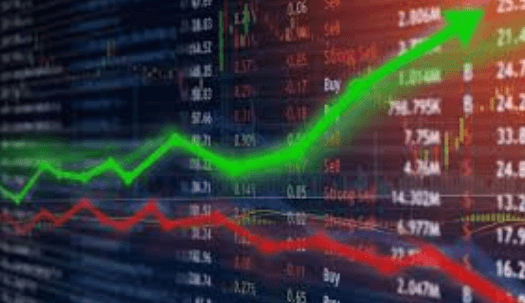As we approach the end of 2021, it’s impossible to ignore the turbulence that has characterized the Dow Jones Industrial Average (DJIA) this year. From trade wars to pandemic woes, a plethora of factors have led to significant shifts in stock market trends and investor sentiment. As an informed investor or trader, understanding what causes these fluctuations is crucial for making informed decisions. In this blog post, we’ll take a deep dive into what’s behind the Dow Jones falling and how various factors are impacting its performance.
Tech Industry’s Impact on the Dow Jones
The tech industry has had a significant impact on the Dow Jones Industrial Average’s performance in recent years. The rise of technology giants such as Apple, Microsoft, and Amazon has contributed to the index’s growth. These companies have become critical components of major indices like the S&P 500 and NASDAQ Composite.
However, factors such as regulatory pressures and concerns over valuations have led to volatility in these stocks’ prices. As a result, investors are increasingly cautious about investing heavily in tech stocks without conducting thorough due diligence first.
Moreover, some analysts argue that the concentration of wealth within this sector is fueling inequality among other industries. This trend may lead to increased scrutiny from policymakers seeking to regulate Big Tech firms more closely.
It’s clear that the tech sector will continue to play an essential role in shaping market trends for years to come. However, investors must remain vigilant when making investment decisions based on stock performance or individual company financials alone.
The Role of Trade Wars in the Dow Jones Decline
The ongoing trade war between the United States and China has been one of the major factors contributing to the decline of Dow Jones. The two nations have imposed tariffs on each other’s goods, leading to an increase in prices and a decrease in demand for products.
Many analysts believe that President Trump’s aggressive stance towards China has played a significant role in sparking this trade war. His administration has used tariffs as a tool to force Beijing into making concessions on issues such as intellectual property theft, market access, and technology transfers.
However, some argue that these measures have hurt American businesses more than they’ve helped them. Many U.
S.-based companies rely heavily on Chinese imports for their manufacturing processes, while also benefiting from China’s large consumer market.
The uncertainty surrounding future trade relations with China has made investors nervous about investing in stocks tied to global supply chains. This fear is reflected by the recent decline of industries linked to international trade like transportation and logistics.
As both countries continue trading blows, it remains unclear when or how this issue will be resolved. Until then, we can expect continued volatility in markets related to global commerce as investors wait anxiously for new developments in the ongoing saga between these economic giants.
COVID-19’s Impact on the Dow Jones
The COVID-19 pandemic has caused a global economic slowdown, affecting the Dow Jones along with other market indices. The initial impact of the virus was felt in China, where it originated, and spread quickly to other parts of the world.
As countries imposed lockdowns and travel restrictions to contain the virus’s spread, businesses shut down or slowed operations. This led to a decline in demand for goods and services, which resulted in reduced revenues for companies.
The technology sector has been one of the few sectors that have benefited from this crisis as remote working increased its relevance. However, many retailers were forced to close their stores temporarily or permanently due to social distancing measures. As a result, consumer spending dropped significantly.
Furthermore, uncertainty surrounding vaccine distribution and new variants of the virus poses additional risks for investors. These factors created instability across all markets worldwide including Dow Jones.
While some industries have fared better than others during this pandemic period such as technology industry but overall drop impacted every industry leading towards an unstable economy which affects globally traded indices like Dow Jones directly contributing towards its fall over time
An Overview of the Key Factors Contributing to the Dow Jones Fall
The Dow Jones has been on a rollercoaster ride in recent times, experiencing sharp drops and gains. A number of factors have contributed to its fall, which can be broadly categorized into three key areas.
Firstly, the tech industry’s impact on the Dow Jones cannot be ignored. The tech sector plays a significant role in the index, with companies like Apple and Microsoft having a major influence. However, concerns over data privacy, regulation and potential antitrust actions against these giants have led to investor caution.
Secondly, trade wars between major economies such as China and the U.
S. continue to cause uncertainty for investors. Tariffs imposed by both sides have disrupted global supply chains while retaliatory measures are causing businesses to reassess their operations.
COVID-19 has had an enormous impact on markets globally including those in America. As businesses shut down due to lockdowns or reduced capacity limits amid pandemic restrictions it impacted overall economic growth leading towards unemployment rates hitting new heights affecting consumer spending patterns too.
Various factors come together contributing towards the Dow Jones falling; however individual circumstances may differ from country to country with varying degrees of severity experienced at different stages throughout this tumultuous year for financial markets worldwide.
Understanding the Current State of the U.
S. Markets
The current state of the U.
S. markets is complex and ever-changing, impacted by a range of factors including political events, economic news, and global trends. Despite recent volatility in the Dow Jones Industrial Average (DJIA), the broader U.
S. stock market has remained relatively resilient.
One key factor that has supported the markets is low interest rates set by the Federal Reserve to encourage borrowing and spending. Additionally, fiscal stimulus measures such as tax cuts have boosted consumer confidence and increased corporate profits.
However, there are also several risks that loom over the markets including trade tensions with China and other countries, geopolitical uncertainty in regions like Iran and North Korea, and concerns over rising levels of debt both domestically and globally.
Another potential risk for investors is inflation which could erode purchasing power over time if prices rise faster than wages. Shifts in technology or industry disruption can also impact specific sectors within the market.
It’s important for investors to stay informed about these various factors shaping market conditions while maintaining a long-term investment strategy focused on their personal goals rather than short-term ups-and-downs in individual assets or indices.
Analyzing the Performance of Top U.
S. Markets
The U.
S. economy is the largest in the world and its markets play a significant role in global financial stability. Therefore, it’s important to analyze the performance of top U.
S. markets to understand why Dow Jones is falling.
Firstly, let’s take a look at the S&P 500 index which tracks 500 large-cap companies listed on American stock exchanges. The S&P 500 has been experiencing volatility due to trade tensions between China and the U.
S., coupled with concerns over slowing global growth.
Secondly, we have the Nasdaq Composite Index which primarily comprises technology stocks such as Apple, Amazon, Microsoft etc. Despite being one of the best-performing indices for several years now, Nasdaq has also experienced declines lately due to increased regulatory scrutiny on big tech firms.
Thirdly, there’s the Russell 2000 Index that tracks small-cap stocks traded on U.
S. exchanges. With ongoing trade tensions creating uncertainty for smaller businesses that rely heavily on exports or imports of goods and services from abroad, this index too suffered losses recently.
By analyzing these three major U.
S. market indices – S&P 500, Nasdaq Composite Index and Russell 2000 Index – investors can gain valuable insights into what drives stock prices up or down during uncertain times like today where both domestic and international factors are impacting Wall Street’s performance negatively
The Impact of Commodities, Currencies, Rates & Bonds on the Dow Jones
The Dow Jones is heavily influenced by various factors, including commodities, currencies, rates, and bonds.
Commodities such as gold and oil can have a significant impact on the stock market. When commodity prices rise, it often signals inflationary pressures that can negatively affect the economy and lead to lower stock prices. Similarly, when commodity prices fall sharply due to oversupply or weak demand, it can cause panic in the markets.
Currencies are also critical drivers of the Dow Jones’ performance. A strong US dollar typically leads to lower exports for major US companies which may result in reduced revenues causing a decline in their share price. Conversely, a weaker dollar makes US goods more affordable overseas leading to higher sales revenue translating into increased company profits.
Interest rates play an essential role in the stock market’s fluctuations since they determine borrowing costs for businesses and individuals alike. Rising interest rates tend to slow down economic growth while reducing corporate earnings making stocks less attractive investments.
Finally bonds – Treasury bonds are considered safe havens for investors during times of uncertainty; therefore if there is an increase in bond yields caused by rising interest rates or inflation concerns this could hurt equities because investors will move their money out of riskier assets like stocks.
In conclusion these four factors influence not only individual securities but also global markets giving important insight into why dow jones falling has been observed recently given events like trade wars & pandemics impacting them all simultaneously along with other forces unique to each one separately
Strategies for Navigating the Current Market Conditions
Navigating the current market conditions can be challenging, but there are several strategies that investors can use to manage their portfolios effectively. Firstly, it’s essential to diversify your investments across different asset classes and industries. This will help you reduce risk exposure and protect your portfolio from sudden market downturns.
Secondly, keep an eye on news events that may impact the markets. Stay informed about factors such as trade deals or global pandemics and adjust your investment strategy accordingly.
Thirdly, avoid making emotional decisions based on short-term market fluctuations. Instead, focus on long-term goals and stay committed to a sound investment plan that aligns with those goals.
Consider working with a financial advisor who has experience navigating volatile markets. They can provide guidance on how to build a resilient portfolio that can weather storms such as economic recessions or global crises.
While it’s difficult to predict the future of the Dow Jones index accurately, understanding its key drivers is crucial for investors looking to make informed investment decisions during uncertain times like these. By following some practical strategies for managing risks and staying disciplined in your approach, you can navigate today’s turbulent markets with greater confidence and success.





 Unlocking the Secrets of Blockchain Wealth through Mining Techniques and Strategies
Unlocking the Secrets of Blockchain Wealth through Mining Techniques and Strategies